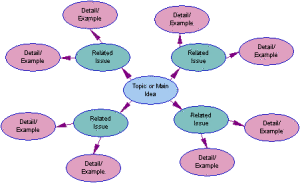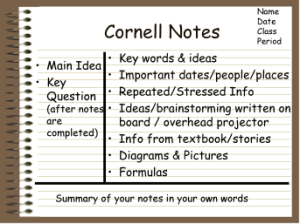Notes are important. They help you organize information. Writing down things by hand makes it easier to remember them. No, really. The act of writing (not typing) helps strengthen the memory of what you’re writing down. They should be written on notepaper, not post-its.
What should you write down? Anything that’s new to you. Your initial handwritten notes don’t have to be neat. They don’t have to be in complete sentences. Write down anything you don’t already know. Write down things that are relevant. If your teacher repeats something, then it’s probably important and should be in your notes.
There are some things that should be in notes:
- Dates
- Names
- Definitions
- Theories
- Examples
- Whatever your teacher writes on the board
Note Format – There are many ways to take notes, and the method you choose should be what works for you. Here are some of the ones to consider:
Hierarchical This is a very organized system kind of like many textbooks. In fact, many classes are organized hierarchically, and it is relatively easy to take notes that match. These have an outline with a main topic, a subtopic, details, another subtopic, more details, a different main topic, etc.
PQRST method – Preview, Question, Review, Summary, and Test. This works with texts that are structured with headings and subheadings.
Preview – Glance at the headings and subheadings in the textbook.
Question – Turn each subheading into a question.
Read – Read the book, paying particular attention to information that answers the questions you came up with before.
Summary – Summarize the topic, bringing in your own understanding. Make notes, diagrams, mind maps, etc.
Test – Write down the answers to the questions you made during the question step.
 Mind Maps Also called Concept Maps. This is more visual and may be more suited to the creative personality. You put a main idea in the middle of the page. Then put topics around it with lines leading from the main idea to the topic. Then subtopics and details hang off of the topics.
Mind Maps Also called Concept Maps. This is more visual and may be more suited to the creative personality. You put a main idea in the middle of the page. Then put topics around it with lines leading from the main idea to the topic. Then subtopics and details hang off of the topics.
 Cornell Notes This is a way to take notes where you include main ideas and details separately. Draw a line down the page about 1/3 of the way in from the left margin. Main topics and questions go in this column.
Cornell Notes This is a way to take notes where you include main ideas and details separately. Draw a line down the page about 1/3 of the way in from the left margin. Main topics and questions go in this column.
Supporting details, definitions, etc. go in the right column. The idea is that while studying , you can cover up the right side, and try to recall all the details for each topic/question. Then check yourself. Keep doing this until you get all of them right.
Later
At home, rewrite the notes (again, by hand if possible). This time you should expand on the short notes. A sentence fragment that reminds of what the teacher said should be expanded into a summary. These are the notes to study from. Think of your two sets of notes as rough draft and polished notes.
